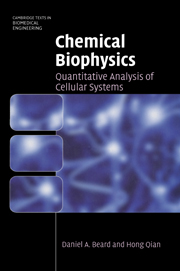Book contents
- Frontmatter
- Contents
- Preface
- Introduction
- Part I Background material
- Part II Analysis and modeling of biochemical systems
- 4 Enzyme-catalyzed reactions
- 5 Biochemical signaling modules
- 6 Biochemical reaction networks
- 7 Coupled biochemical systems and membrane transport
- Part III Special topics
- Bibliography
- Index
4 - Enzyme-catalyzed reactions
Published online by Cambridge University Press: 05 June 2012
- Frontmatter
- Contents
- Preface
- Introduction
- Part I Background material
- Part II Analysis and modeling of biochemical systems
- 4 Enzyme-catalyzed reactions
- 5 Biochemical signaling modules
- 6 Biochemical reaction networks
- 7 Coupled biochemical systems and membrane transport
- Part III Special topics
- Bibliography
- Index
Summary
Overview
There is almost no biochemical reaction in a cell that is not catalyzed by an enzyme. (An enzyme is a specialized protein that increases the flux of a biochemical reaction by facilitating a mechanism [or mechanisms] for the reaction to proceed more rapidly than it would without the enzyme.) While the concept of an enzyme-mediated kinetic mechanism for a biochemical reaction was introduced in the previous chapter, this chapter explores the action of enzymes in greater detail than we have seen so far. Specifically, catalytic cycles associated with enzyme mechanisms are examined; non-equilibrium steady state and transient kinetics of enzyme-mediated reactions are studied; an asymptotic analysis of the fast and slow timescales of the Michaelis–Menten mechanism is presented; and the concepts of cooperativity and hysteresis in enzyme kinetics are introduced.
While the majority of these concepts are introduced and illustrated based on single-substrate single-product Michaelis–Menten-like reaction mechanisms, the final section details examples of mechanisms for multi-substrate multi-product reactions. Such mechanisms are the backbone for the simulation and analysis of biochemical systems, from small-scale systems of Chapter 5 to the large-scale simulations considered in Chapter 6. Hence we are about to embark on an entire chapter devoted to the theory of enzyme kinetics.
- Type
- Chapter
- Information
- Chemical BiophysicsQuantitative Analysis of Cellular Systems, pp. 69 - 104Publisher: Cambridge University PressPrint publication year: 2008
- 1
- Cited by



